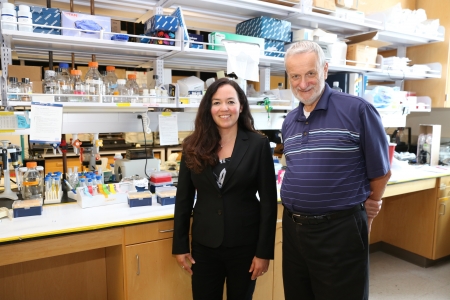 Sept. 12, 2016 - UC Irvine’s Laboratory for Fluorescence Dynamics (LFD) has received a five-year, $7.2 million operating grant from the National Institutes of Health (NIH). This marks the 30th year of NIH funding for the lab, the country’s only national research center dedicated to fluorescence.
Sept. 12, 2016 - UC Irvine’s Laboratory for Fluorescence Dynamics (LFD) has received a five-year, $7.2 million operating grant from the National Institutes of Health (NIH). This marks the 30th year of NIH funding for the lab, the country’s only national research center dedicated to fluorescence.
The LFD is a state-of-the-art laboratory that uses fluorescence with advanced imaging technologies (microscopy and spectroscopy) to view live cells and study cellular processes. The research can lead to a better understanding of cell function, with potential applications in diagnosing and identifying treatment for many human diseases, including Huntington's disease, kidney disorders and cancers. The NIH grant will help LFD continue its work developing new imaging technologies and methods in fluorescence as well as support the dissemination of the latest advances in the field.
Enrico Gratton, principal investigator for the lab and a professor of biomedical engineering, established the lab in 1986 while a professor at the University of Illinois at Urbana-Champaign. He moved LFD to UCI in 2006.
Since its move to UCI, the lab has developed new microscopy methods to detect molecular aggregates and the movements of single protein molecules in live cells and tissue samples.
“This is one of the unique technologies developed at the LFD and now used in many laboratories around the world,” said Gratton. Another important development in fluorescence microscopy at UCI was the introduction of the phasor method for the analysis of fluorescence decay time in entire cells and tissue. This technology allows determination of metabolic levels in cells, with specific application to diseases such as cancer, diabetes and other such diseases that alter cells’ metabolism.
The lab provides technical assistance and user-friendly service for visiting scientists who come from around the world. Proceeds from LFD's data analysis software, Globals for Spectroscopy and Globals for Imaging, are used to fund research-related conferences and workshops.
“This grant allows us to continue our work in developing new fluorescence instrumentation for biomedical applications and basic research,” explained co-investigator and biomedical engineering Assistant Professor Michelle Digman. “It also strengthens our mission to spread knowledge and training to the scientific community. These opportunities enable not only developments but create novel ways for scientists to solve the driving biological questions of the day.”
A special symposium, Frontiers in Biological Fluorescence, will be held Sept. 30 at the Beckman Center to celebrate LFD’s 30th anniversary and the 70th birthday of its founder, Gratton.
-Lori Brandt
